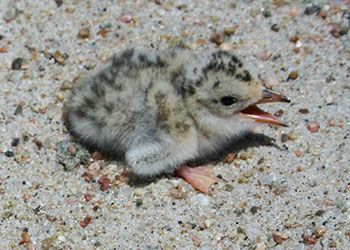With a weight of approximately 1 ounce and a length of approximately 9 inches, the interior least tern is the smallest of the gull and tern family. Males and females appear identical with a black crown, white forehead, gray back, gray wings above with white below, orange legs, and a black-tipped yellow bill. Immature birds have darker feathers, a dark bill, and dark eye stripes on their white heads.

The interior least tern arrives on its breeding grounds in Nebraska and other Midwestern states in early May to nest in small groups. They form their nests by scraping indentations in sandbars and gravel beaches. These nests may be lined sparingly with small shells or other debris. Eggs are commonly laid in clutches of 2 to 3 from late May through early August, and are incubated for about 20 days. The young fledge in 19 to 20 days. Nesting success depends on the presence of bare or nearly barren sandbars, favorable water levels during nesting, and abundant food. Interior least terns feed mostly on small fish caught by skimming the surface of the water or by making dives from the air. Least terns are very defensive and adults scream, dive, and sometimes defecate on intruders. By late August or early September, they migrate south to wintering grounds along the Gulf of Mexico. Interior least terns may live up to 21 years.

The interior least tern is an integral part of the fauna of Nebraska and, historically, flourished along the Missouri River and its tributaries including the Platte River. However, the interior least tern was listed as an endangered species in 1985. Loss of nesting and over-wintering habitat is the major reason these birds have declined in number over the years. Interior least terns require a sandy, beach-like surface mostly free of vegetation for viable nesting, which have been significantly reduced over the last half century due to dams, diversions, and other water management measures. Today, the total population of interior least terns is estimate at 17,000 to 23,000 individuals. As part of its overall habitat management plan, the Crane Trust actively contributes to the recovery of interior least terns by clearing vegetation from sandbars and sand pits for nesting on Shoemaker Island. Additionally, the Crane Trust collaborates with the U.S. Geological Survey and the Platte River Recovery Implementation Program, with support from the Central Platte Natural Resources District to band and monitor interior least terns nesting at the Crane Trust.
Video Credit: Platte Basin Time-lapse Project

